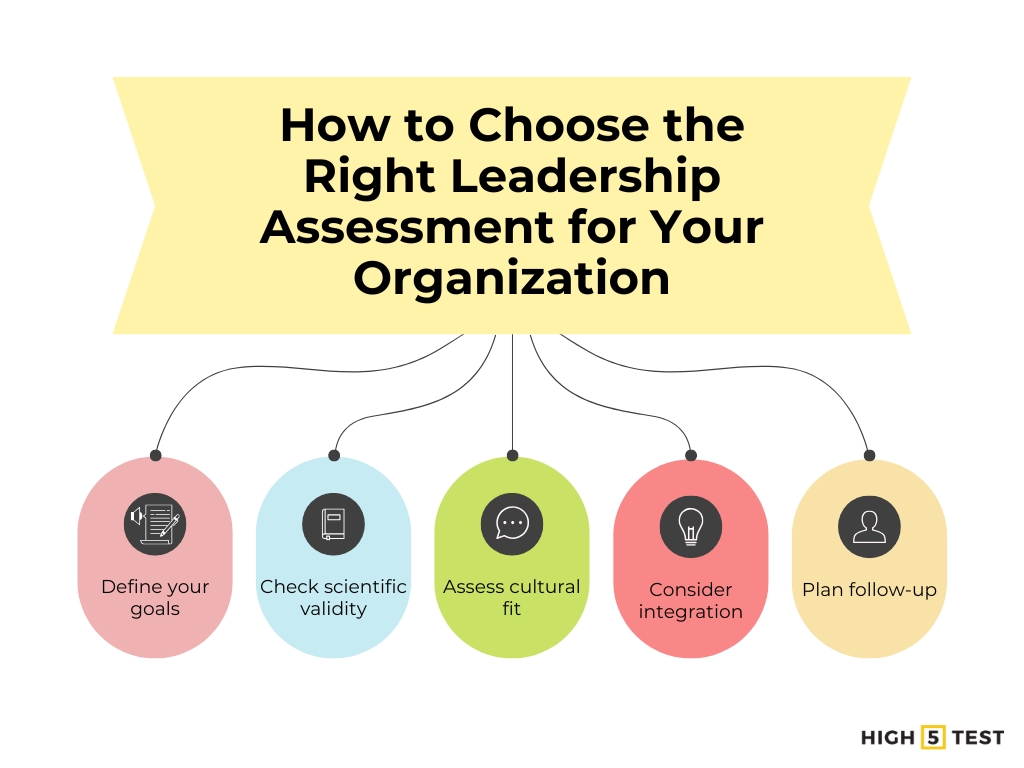
What is a leadership assessment?
A leadership assessment is a structured evaluation that measures an individual’s ability to lead, influence, and inspire others. These tools are designed to identify leadership potential, evaluate specific competencies, and provide actionable feedback that supports personal and professional growth.
Common leadership assessment tools include:
- Psychometric tests
- 360-degree feedback surveys
- Situational judgment tests
- Behavioral interviews
Each method highlights different aspects of leadership, such as emotional intelligence, decision-making, communication, and team motivation.
In modern organizations, leadership assessments function as strategic tools that help build a strong pipeline of future leaders.
In short, a leadership assessment helps individuals and organizations understand how leadership potential aligns with business needs and long-term goals.
The purpose of leadership assessments
Leadership assessments do more than evaluate performance. These tools help reveal potential, direct development efforts, and support better placement of people in leadership positions.
Here are the main purposes:
1. Identifying leadership potential
One of the most important purposes of leadership assessments is identifying emerging leaders. Assessments reveal natural inclinations toward leadership behaviors such as strategic thinking, adaptability, and emotional intelligence.
This information supports succession planning and talent management. HR teams and executives can promote promising people from within and reduce reliance on external hiring.
Example: A leadership potential assessment can identify high-potential employees early so the organization can prepare them for future leadership positions.
2. Building self-awareness and growth
Strong leaders are self-aware. Leadership assessments help individuals see their strengths, blind spots, and behavioral tendencies. This awareness is the foundation of emotional intelligence and effective leadership.
Leaders who see how their actions affect others can adjust their behavior. This leads to stronger relationships, clearer communication, and more genuine leadership.
3. Aligning leadership with organizational goals
Every organization has its own culture and strategy. Leadership assessments ensure that leadership styles and values align with organizational goals.
For example, a company that values innovation will look for leaders who show creativity, openness, and comfort with calculated risk. A compliance-focused organization may prioritize consistency, accuracy, and structure.
This alignment keeps leadership behavior and business strategy moving in the same direction.
4. Supporting data-driven talent decisions
Leadership assessments add objectivity and evidence-based decision-making to hiring, promotion, and development processes. Instead of relying on subjective opinions or bias, organizations can use data to accurately evaluate leadership potential.
This approach reduces costly hiring errors and supports fair, transparent talent management decisions.
5 key benefits of leadership assessments
The benefits of leadership assessments extend to individuals, teams, and the organization as a whole. When done correctly, they become powerful catalysts for growth and performance improvement.
1. Improved leadership performance
Leadership assessments highlight leadership strengths and development areas. Leaders can then focus on the most important skills and behaviors. Structured feedback supports coaching and self-improvement.
Leaders who act on assessment results tend to perform better, inspire stronger team engagement, and respond faster to organizational challenges.
2. Stronger team performance and engagement
A leader’s behavior strongly influences team morale and productivity. Leadership assessments help leaders understand how their style affects team performance.
Leaders who communicate clearly, delegate thoughtfully, and build trust tend to create teams that are more engaged and aligned with organizational objectives.
3. Strategic succession planning
Organizations use leadership assessments to build leadership pipelines. By identifying potential successors for key positions, companies protect business continuity when senior leaders move on.
Succession planning based on leadership data helps prevent gaps and supports long-term stability.
4. Personalized leadership development programs
Each leader brings a different mix of strengths and challenges. Assessments make it possible to create tailored leadership development programs that match individual needs.
For example, if an assessment shows that a manager is strong in strategic thinking but needs to strengthen empathy, coaching and training can focus on that area. This targeted approach helps development investments produce clear results.
5. Strengthened organizational culture
When leadership assessments are used across the organization, they support a culture of transparency, growth, and accountability. Leaders who receive feedback and act on it model continuous improvement and encourage others to do the same.
The result is a workplace culture that values open communication, collaboration, and personal development.
Types of leadership assessments
Leadership assessments come in various forms, depending on the competencies and traits being measured. Here are the most common types:
- Personality-based assessments: Tools like the HIGH5 Leadership Test, MBTI, or Big Five assess personality traits linked to leadership potential.
- Behavioral and competency assessments: These assess how individuals act in specific situations and how their behavior reflects core leadership competencies.
- 360-degree feedback tools: These gather feedback from peers, direct reports, and managers to create a broad view of leadership behavior.
- Situational judgment tests: These present real-life scenarios and assess decision-making, problem-solving, and ethical judgment.
Each type serves a unique purpose, and combining multiple methods yields the most accurate leadership profile.
How to choose the right leadership assessment for your organization
Selecting the right leadership assessment depends on your organization’s objectives and context. Here’s what to consider:

- Define your goals: Identify if your focus is on finding high-potential employees, developing current leaders, or improving team performance.
- Check scientific validity: Choose tools backed by psychological research and data reliability.
- Assess cultural fit: Ensure the assessment aligns with your organization’s values and leadership framework.
- Consider integration: Look for assessments that can be linked to training, coaching, or performance reviews.
- Plan follow-up: The true value of assessment lies in post-assessment coaching and action planning.
Tip: A tool like the HIGH5 Leadership Assessment provides scientifically validated insights into natural strengths, making it ideal for ongoing leadership development.
Best practices for implementing leadership assessments
To maximize impact, organizations should approach leadership assessments strategically:
- Communicate the purpose clearly: Explain that assessments support development, not punishment.
- Maintain confidentiality: Protect assessment data to build trust and openness.
- Combine quantitative and qualitative inputs: Use a mix of data points and interviews for a holistic view.
- Provide coaching support: Provide professional development support to help leaders act on results.
- Integrate into Continuous Learning: Make leadership assessment a recurring process, not a one-time event.
When implemented well, leadership assessments become the foundation of a robust leadership development system.
Real-world example: Right Management leadership assessment case study (ManpowerGroup)
A real-world example of effective leadership assessment comes from Right Management, a part of ManpowerGroup. In this case study, a large, global professional services organization partnered with Right Management to accelerate the careers of its high-potential (HiPo) leaders.
The company aimed to broaden and deepen its leadership pipeline. It also sought to secure top talent for future C-suite positions, guided by the mantra “what got us here won’t get us there”.
The solution was a 12-month Strategic Leadership Program that combined four core elements:
- Self-awareness diagnostics: Participants completed a series of questionnaires, including 360-degree feedback and self-assessments.
- Business simulation: In a “business challenge lab,” leaders worked on the strategic goals of a complex, fictitious global company.
- Mentoring and coaching: Leaders joined reverse mentoring with junior employees, received guidance from the executive team, and worked with a professional coach in 1:1 sessions.
- Innovation bootcamp: An intensive experience that shifted mindsets and equipped leaders with practical new toolkits.
Right Management reported strong results from the program. Over two years, 36 leaders took part, and 53% earned promotions into new positions during the 12-month program. Managers also noted a 23% increase in participants’ “future potential” and a 29% increase in their “tolerance for ambiguity.” The program was an intensive experience that shifted mindsets and introduced practical toolkits.
Reference: Right Management UK – Case Study: Enabling the development of high-potential leaders
This example demonstrates how structured, scientifically grounded assessments can unify leadership standards globally and directly impact organizational effectiveness.
The strategic value of leadership assessments
Leadership assessments are far more than evaluation tools; they are strategic enablers of growth, performance, and culture. When used consistently, these tools help build a stronger bench of leaders who are self-aware, aligned with strategy, and prepared for greater responsibility.
For individuals, assessments act as a mirror that highlights both strengths and gaps. Leaders who act on these insights can communicate more clearly, build healthier teams, and make better decisions under pressure. For organizations, the message is simple: treat leadership assessment as an ongoing practice, connect it with coaching and development, and use the results to shape a more confident and capable leadership group.






